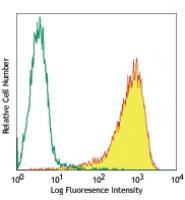Pacific Blue™ anti-human CD69;Isotype:Mouse IgG1, κ;Reactivity:Human, Cross-Reactivity: Chimp
详细描述
|  | ||||||||||||
| Description | CD69 is a 27-33 kD type II transmembrane protein also known as activation inducer molecule (AIM), very early activation antigen (VEA), and MLR3. It is a member of the C-type lectin family, expressed as a disulfide-linked homodimer. Other members of this receptor family include NKG2, NKR-P1 CD94, and Ly49. CD69 is transiently expressed on activated leukocytes including T cells, thymocytes, B cells, NK cells, neutrophils, and eosinophils. CD69 is constitutively expressed by a subset of medullary mature thymocytes, platelets, mantle B cells, and certain CD4+ T cells in germinal centers of normal lymph nodes. CD69 is involved in early events of lymphocyte, monocyte, and platelet activation, and has a functional role in redirected lysis mediated by activated NK cells. |
| Formulation | Phosphate-buffered solution, pH 7.2, containing 0.09% sodium azide. |
| Recommended Usage | Each lot of this antibody is quality control tested by immunofluorescent staining with flow cytometric analysis. The suggested use of this reagent is ≤ 1.0 microg per 106 cells in 100 microL volume or 100 microL of whole blood. It is highly recommended that the reagent be titrated for optimal performance for each application. |
| References | 1. Knapp WB, et al. 1989. Leucocyte Typing IV. Oxford University Press. New York. |

